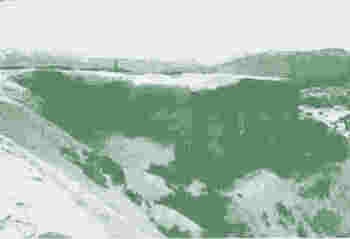
The Author in Silhoutte at Key Italian Fort Campolongo
The Austrian Fortress Line Lies About 12 Miles in the Distance
The least mountainous area of the horseshoe-shaped 400-kilometer Austro-Italian border is the Trentino Plateau or Altopiano. Each nation built a line of concrete and iron fortresses, set back five kilometers from the actual frontier. These 14 forts utilized the region's immense cliffs and mountaintop rock, as well as satellite batteries and garrisons for their defense.

Fort on Monte Verena Which Fired the War's First Shots
The Forts of the Altopiano
Both Austrian and Italian forts were of similar design and armarment. Each fort
had reinforced concrete walls of up to three meters thick, with the big guns
inside cast iron cupolas 180 to 200mm thick. These dimensions were designed
[theoretically] to withstand the great fort killer of the day- the Skoda 305mm
howitzer. On average, a force of 200 manned each fort- 140 artillerymen and 60
fortress infantry for final protective fire and to work the machineguns. All
of these fortresses were supplimented by additional nearby garrisons, batteries
of cannon and mortars, spotlights and a network of barbed wire fields. {I list
only one example for each side}.
| Austrian Fort |
Campo Luserna
1549m. alt. |
4 100mm howitzers |
2 80mm cannon
2 60mm cannon |
19 8mm MGs |
Italian Fort
|
Cima Campolongo
1720m. alt |
4 150mm howitzers |
4 75mm cannon |
4 6.5mm MGs |
Today most of these forts are shattered ruins on isolated mountaintops. One
however, Fort Belvedere, has been partially restored and can be toured from
April to October.
|
It was on the rugged, heavily forested plateau called the Altopiano that the first shots of Italy's war were fired from Monte Verena's four 150mm guns. It was also here that the front's largest battle outside the Isonzo would occur, the Strafexpedition - Austria's Chief of Staff Conrad von Hotzendorf's "punishment" of Italy for breaking the Triple Alliance..

Austrian Fort Verle Under Fire
With 18 fresh infantry divisions and over 2000 guns, including 20 batteries of 305mm howitzers, the Austrian Strafexpedition was launched on 15 May 1916. This concentrated attack stretched 65 kilometers from Pasubio to Ortigara. Once off the plateau, Conrad's army had only to advance across the northern Italian plain a short 60 kilometers to Venice and the sea. The Carnic and Isonzo fronts would be cut off and enveloped and Italy would fall. In five days the Austrians advanced eight kilometers; maximum penetration was 20 kilometers. Although outgunned and outnumbered, the Italian resistance was tenacious and deadly. Trains and truck convoys rushed reinforcements from the Isonzo to the battle.

Battered Austrian Fort Near Folgaria
Did Not Fall Until the Armistice
Four of the seven Italian forts were destroyed or captured, including Monte
Verena, where a single 305 round hit the magazine and killed most of the
artillerymen inside. The Altopiano's towns of Asiago and Arsiero were bombarded and overrun as well. Despite these successes, Conrad had not expected such taxing opposition, delays and losses

Direct Hit on Mt Verena Turret During 1916 Offensive
. One week after the Brusilov Offensive [4 June] began in Russia, the Strafexpedition was called off. By mid-July an Italian counter-offensive would regain most of the lost territory. The Austrians had failed to break out of the Alpine barrier. Casualties suffered in the Trentino offensive of 1916 were 150,000 for the Italians and 83,000 for the Austrians.

Damaged Fort Campolongo in 1916
Exactly one year later a similar battle would rage on and around Monte Ortigara with identical bloody results. The classic static warfare of WW1: trenches, barbed wire and mines would contain the Altopiano for the remainder of the war.
|










